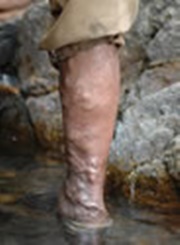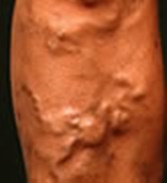
The word ‘varicose’ comes from the Latin root ‘varix’ which means twisted. While veins anywhere in the body can become varicose, the veins most affected by varicose veins are those in the legs (often on the backs of calves or inside of legs). This is due to the larger pressure exerted on these veins from sustained standing, walking or other factors. An example of painful varicose veins found elsewhere in the body is hemorrhoids, which are simply varicose veins found in the anus.
While varicose veins are often unsightly and do cause cosmetic concerns, they can cause very significant symptoms and also be indicative of underlying vein disease, which may progressively get worse if not treated. Varicose vein symptoms (aside from the bulging veins) may include painful varicose veins, leg heaviness, leg fatigue, swelling, skin discoloration, itching and burning.

When this valve failure (or venous reflux) occurs in veins of the leg, the blood flows backwards (or back down the leg) and pools in the veins of the lower leg. This increased blood pressure causes the veins to bulge or swell, and may cause fluid to leak outside the vein (causing generalized swelling in the ankles and feet). Since the blood in these veins is deoxygenated, it often makes the varicose veins appear blue in color.
Without treatment, this increased pressure within the legs can progress to cause additional valve failure (causing the varicose veins to ‘grow’ up or down the leg), skin color changes, and in its worst case, non-healing venous ulcers.
Painful varicose veins can be treated with a number of safe and effective options. Only a trained vein specialist can determine the extent and severity of any vein disease you may have, so consult with a physician to learn more.